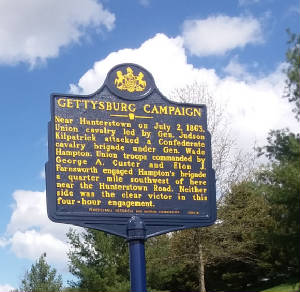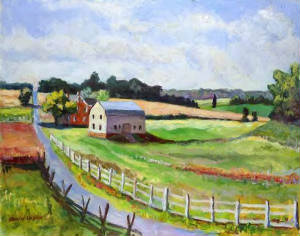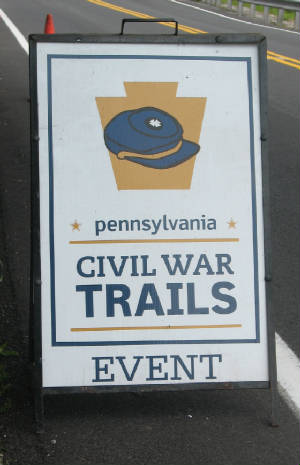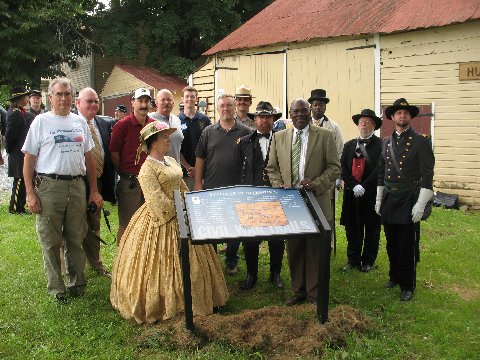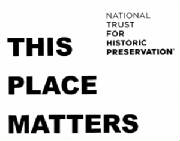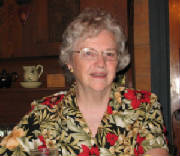|
North Cavalry Battlefield July 2, 1863 Gettysburg Campaign
Civil War Battlefields - James O. Phelps - Panoramics
360* Panoramics @ Gallery 30, Gettysburg, PA
In Memory of Those who Fought and
Died for
Our Freedom. "These
Dead Shall Not Have Died in Vain." ~ President Lincoln ~
| RT 394 & Hunterstown Road |
|
|
| New Custer Memorial, dedicated July 2, 2008 |
"We stopped at the new Hunterstown Memorial to General Custer and the Battle of Hunterstown.
I must
say I had never heard of the battle before. I now believe this highly overlooked battle was a major part of the reason the Union held on to
victory during that hard fought 2nd day. Another 2100 rebel troops attacking East Cemetary Ridge surely would have turned the tide
and
the day would have belonged to the Confederacy! I shudder to think what America would be like today if the Battle of Huntertsown had not been fought." ~
Harold D. Sausser, July 6, 2013
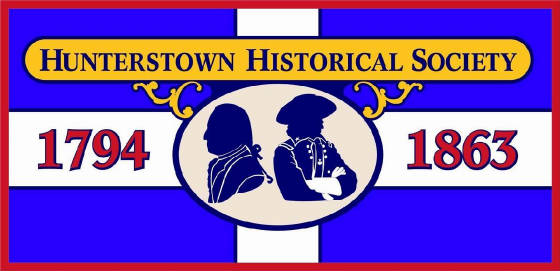
|
| Co-Founders: Roger & Laurie Harding |
"Too
often, places that matter to us can be lost in a heartbeat — sometimes even before we realize they will be missed. The
best way to save a place that matters is to call attention to it and value it before it is endangered."
National Trust for Historic Places
Battlefield Panoramics - James O. Phelps
| The Felty Farm/ North Cavalry Battlefield |
|
|
| by Edwin L. Green, Williamsburg, VA. |
"General George Armstrong Custer
is an unsung hero of the Battle of Gettysburg, for without his gallant charges, the Confederates would have broken through
the Union resistance. Critics often cite his high casualty rate in the battle as poor performance. General Custer knew the
Rebel advance had to be stopped at all costs. He didn’t order his men into a known high casualty fight. He LED
them. I wonder how many armchair quarterbacks would have changed seats with him?" "CusterLives!" Website Quote
“The [Civil] war “proved Custer was simply the greatest
cavalry tactician of the Union Army, perhaps the greatest of either army North or South. The fame and rewards he gained were more than earned by not just his boldness and
courage but his military acuity.”
Stephen Budiansky
| Unveiled by GBC&VB on 7/2/09 |
|
|
| Located at The Historic Tate Farm |
Shown
in picture: Background
...Steve Alexander as Brigadier General George Armstrong Custer, Michigan Wolverines, John Volhken, & Dan Dunn Author, Frank Meredith, GBC&VB's Norris
Flowers, Authors, J D Petruzzi, Mike Nugent, & Steve Stanley, Artist, Jared Frederick, GNP Ranger, Troy Harman Actors & Living Historians, Mrs. Julia Dent Grant with General Ulysses S. Grant, Lenwood Sloan & PA Museum's Living
Historians
| Our Thanks to Bob McIlhenny & Fred Kammerer! |
|
|
| ~ 2013 ~ |
Did You Know...
Hunterstown, formerly called Woodstock,
is one of the oldest towns in the country.
It was settled in the mid 1700's by David Hunter,
a Revolutionary War soldier,
for whom the
town was named. In fact, because
he had been training militia here in Hunterstown, Lord Dunmore, Govenor of the colonies in Williamsburg, put a bounty on David Hunter's head, "dead or alive"... To this very day, no one knows where David Hunter is buried.
|
|
| Click here to read more... |
Hunterstown,
Pennsylvania
July 2, 1863
Known by historians
as "North Cavalry Field,"
Hunterstown was recently recognized by the National
Parks Service (Sept. '06) as part of the Gettysburg Campaign.
Unfortunately,
the site is extremely vulnerable
to development and is still unprotected.
"And though Hunterstown is a new
addition (2006), Lawhon said there is still work to do to help preserve the land within the boundaries of the Gettysburg National Military Park."
... Evening Sun quote
Battle History...
Will Hutchison's Thoughts ....
Books on the Battle of Hunterstown...
Michigan Cavalry & George Armstrong Custer
"A
major Alton (Illinois) developer, Charles Hunter, was one of Alton's best known Underground Railroad conductors. His Hunterstown area, founded in the 1830's, had many free Blacks as residents, some of whom were escaped slaves.
He was also the only landowner who allowed Elijah Lovejoy to live on his property. "
To read more...
| National Trust's "This Place Matters" |
|
|
| Members of Hunterstown Historical Society/Tate Farm |
To View the Historic Village of Hunterstown...
| Mrs. Linda Cleveland |
|
|
| HHS 2010 "Historian of the Year" |
HUNTERSTOWN, PENNSYLVANIA "A
small but significantly Historical Village" Hunterstown, Pennsylvania
is located on Route 394 one mile east of the Hunterstown Exchange of Route U.S. 15 North of Gettysburg. After the American Indians made their trade routes west of the Susquehanna River through
this area, immigrants started to settle along their trails. Many were Scotch-Irish. The Penn proprietors of the land through
this area, which is now Hunterstown, granted Michael Drumgold a warrant for 100 acres on June 8, 1749. In October the same
year surveyor Thomas Cookson laid out a total of 182 acres for Drumgold. It was on October 8, 1760 Michael and Margaret Drumgold
sold this land to David Hunter. On March 14, 1764 the Penn heirs awarded Hunter a patent deed for the 182 acres granting him
the full and complete title he desired to establish a village. On
April 2, 1764 David Hunter gave William Galbreath a deed for the first lot "situate in the town of "Straban"
as it was called then. Later it was referred to as "Woodstock". As lots were sold, small log homes were built. Later
weather-board and brick dwellings appeared. As the year 1800
was drawing nigh the village was appropriately named after its founder and called Hunterstown. A county seat was being sought
for the new county of Adams and Hunterstown vied for that status. It was centrally located as far as population in the county
and it was located on "The Great Road" from York to Pittsburgh by the way of "Black’s Gap". The
town of Gettysburg received the final honor as County Seat. One
special landmark in Hunterstown is the Historic Tate Farm and Blacksmith Shop. In October 1794 President George Washington
had the occasion to stop here. Because of the taxation put on liquor, many in western Pennsylvania were rebelling and decided
they were not going to abide by the law. President Washington called up troops from four states and he himself went by carriage
and horseback to review the troops, 15,000 strong, in Carlisle and Bedford and planned how they were to quell what was called
the Whiskey Rebellion. This was accomplished without any major fight. On returning to Philadelphia, the capitol at that time,
a horse in the President’s party threw a shoe and they stopped in Hunterstown at the Tate Farm blacksmith shop near
Beaver Dam Creek to have it shod. Just fields away from
the Tate Farm is the Felty and Gilbert Farms where Brigadier General George Armstrong Custer’s Cavalry under the direction
of Brigadier General Hugh Judson Kilpatrick met in battle with General Wade Hampton’s Division of J.E.B. Stuart’s
Cavalry on July 2, 1863. This battle, now referred to as North Cavalry Field, is viewed as having a significant bearing on
the remainder of the Battle of Gettysburg. Here Brigadier General George Armstrong Custer set a "trap" for the enemy
in which he narrowly escaped losing his own life. Kilpatrick reported 32 dead and wounded of his division of some 3,500. The
confederates suffered around 100 casualties in the fighting of 2,000 involved. In the center of Hunterstown is the Grass Hotel built before the Civil War. The hotel served as temporary
Union headquarters for Brig. General Judson Kilpatrick during the battle of Hunterstown and afterwards served as a hospital
for the north and south. A number of officers died here. The
Great Conewago Presbyterian Church was organized in 1740. They met in a log structure until a fieldstone church was built
in 1787. It is still in use today. It also served as a hospital during the Civil War. The adjacent cemetery contains gravesites
of Revolutionary War soldiers and Civil War veterans along with generations of local inhabitants. In 1885 the Galloway Brothers opened a copper mine just north of the village. After several
years it closed and the township used the copper/gold bearing rock for the streets and roads. So they claimed "the roads
were paved in gold." The mine was opened once again by the Reliance Mining and Milling Company of Arizona in 1905. Although
it was not hugely successful it employed 20 local men working "around the clock." The mine was abandoned in 1916.
Through
the 19th and 20th century the village had a two-room country school and a Methodist Church on the main
street, both are still existing but not used today. Among
the early inhabitants of the village were a doctor, undertaker, watchmaker, shoemaker, carpenter, tailor, and wagon maker.
During the 1830’s John C. Studebaker, a blacksmith, and his skilled employees built conestoga-type wagons in a shop
between Hunterstown and Heidlersburg. He ventured to Ohio and then to South Bend Indiana to have the largest company for manufacturing
wagons and carriages and later through his descendants the Studebaker automobile. Over the years Hunterstown had many small country stores, a post office, creamery, fruit-packing house, millinery
shop, gun club and horse race track. As many as ten families made chairs as early as 1830’s into the early 1900’s.
It once had a military guard unit and a baseball team. The village currently has two churches, a dog kennel and grooming establishment,
a horse-boarding farm with lesson programs, a childcare center, a tea room, go-cart track, car body shop, transmission shop,
and vintage car shop. Hunterstown, population 100, a village
rich in history where the desire of its people is to restore and preserve what it now has to share with others. Here you can’t
help but feel the heart beat of the past and imagine those who walked and rode these once dusty roads. You may hear the distant
toll of the school bell, the happy sounds of children at play or music from the old church pump organ. You may hear the hoof
beats of the cavalry approaching or the sound of the artillery that echoed over the village. Memories linger of the mournful
groans of the injured and dying in the fields and makeshift hospitals and the prayers of the faithful as they gave their last
full measure here.Hunterstown, Pennsylvania – A quaint little village with A story to tell! Linda K. Cleveland Straban Historical
Reflections Historian – Hunterstown Historical Society Revised - 2009
Local and National Contacts...
Civil War Preservation Trust
Congressman Scott Perry 717-334-3430
State Representative
Dan
Moul
717-334-3010
|
|
|
3/13/2007
Evening Sun's Meg Bernhardt writes...
Gettysburg, Hunterstown feel development pressure By MEG BERNHARDT
Evening Sun Reporter Article Launched: 03/13/2007 10:06:23
AM EDT
The
casino proposal might have failed in Adams County, but a national preservation group that lobbied to stop it says the Civil
War battlefields here are still endangered. Development
pressure throughout Adams County, including a massive 2,000-home development and a recently torn-down barn at Hunterstown
sparked the Trust to include Gettysburg and Hunterstown on its annual endangered list, said Civil War Preservation Trust spokeswoman
Mary Goundrey. "You can
build a house anywhere but you can't move hallowed ground," Goundrey said. The list is used to raise awareness of sites with impending threats and guide the Trust's
preservation efforts throughout the year. Hunterstown,
located northeast of Gettysburg in Straban Township, is the site of a vicious cavalry clash that helped decide the outcome
of the Gettysburg battle on July 2, 1863. For many years, it has remained overlooked by preservationists and historians. Then, a few years ago, local preservationists started meeting,
and a few historians started studying it, labeling it "north cavalry field" following the pattern of east and south
cavalry fields. It started drawing crowds of hundreds to tours, and proponents said it should be added to the sacred sites
frequently toured by visitors to Gettysburg. At
the same time, its fate came into question, as developer Rick Klein proposed a 2,000-home seniors-only development on the
battlefield and a local farmer tore down the historic Felty barn, the centerpiece of the battle where Gen. George Custer is
said to have shown his true colors as a commander. In September, the National Park Service added Hunterstown to its field study of the Gettysburg battle
by the American Battlefield Protection Program, a move which caught the attention of the Civil War Preservation Trust as it
was accepting nominations to the list. Letters
started pouring in from locals near Hunterstown and Civil War enthusiasts who visited it often, Goundrey said. Laurie Harding, one of the leaders of the group Hunterstown
Historical Society, previously known as the Friends of Hunterstown, found out about the announcement Monday. "Everybody here will be thrilled," Harding said.
"I still would like to know exactly what it's going to mean for us." Harding and her husband, Roger, have lobbied the Civil
War Preservation Trust for years to bring recognition to Hunterstown. But when they didn't hear anything, they gave up
on support from the Trust – a big disappointment since it is the largest nonprofit battlefield-preservation organization
in the United States. But
with the National Park Service designation including it in the Gettysburg battle and national attention because of a recent
casino controversy, the Civil War Preservation Trust began showing interest. Now, the Hardings are looking into an ongoing court case in York County in which a group
of preservationists is claiming local governments must protect historic resources under the Pennsylvania Constitution. They
hope the Trust can provide them with advice and guidance on the matter, Harding said. Meanwhile, the Pennsylvania Museum and Historical Commission and Gettysburg National Military
Park are working with Klein to preserve a homestead on the battlefield and establish some interpretive markers along the battlefield.
Klein has said the battlefield area will not be developed for at least four or five years, and will be done with history in
mind. Gettysburg National
Military Park spokeswoman Katie Lawhon said the park was happy to hear about the Trust's continued concern about the preservation
of the area. Lawhon said it's possible there will be interpretive connections directing visitors to the park to see Hunterstown,
which lies outside the park's boundary, but is not certain if it would involve any park funding or staffing. But she did
mention the battlefield is now eligible for federal grants through the Park Service's broader battlefield protection program.
And though Hunterstown is
a new addition, Lawhon said there is still work to do to help preserve the land within the boundaries of the Gettysburg National
Military Park. Since the Trust's
list began in 2001, Gettysburg has been included every year except 2005. The Trust has protected 697 acres at Gettysburg,
including helping with a recent conservation easement on the Cunningham Farm. But there are still 1,134 acres within the park's boundaries that are not protected,
Lawhon said. Many of them, including the toll house on Chambersburg Pike, are undeveloped and still contain Civil War-era
structures. But the park has
not received any funds for land preservation since 2001, so it cannot buy the properties or the development rights to them.
"We are 100-percent dependent
on the CWPT and these other organizations to help us save these lands," Lawhon said. The battlefields on the Trust's list were chosen based on geographic location, military
significance and the immediacy of current threats. Contact Meg Bernhardt at mbernhardt@eveningsun.com. |
|
3/2/2007
Congressman Todd Platts Gives His Word of Support...
In a letter dated February 14, 2007, Congressman Platts responds
to a letter written by preservationist, Bob Resig, from Hanover, Pa:
Dear Mr.
Resig:
..."As you are aware, Hunterstown was recently included in the National Park's Service American
Battlefield's Protection Program (ABPP). The goals of the ABPP are to protect battlefields and sites associated with armed
conflicts that influenced
the course of our Nation's history by raising awareness and planning for preservation.
Hunterstown was the site of a cavalry battle on July 2nd, 1863, the second day of the three-day Battle of Gettysburg.
I agree that it is important to preserve the integrity of this historic landmark.
Please know that it is
my understanding that the Gettysburg National Military Park and the Pensylvania Historical and Museum Commission are working
with the developer to set aside land to preserve from the developement. Rest assured that I will keep
the the Civil War Battlesite in Hunterstown in mind as I work with my staff to establish legislative priorities for the new
session of Congress"....
Sincerely,
Todd Russell Platts
Member of Congress
19th District,
Pennsylvania
8:27 am est
|
|
|
 |
|
Contact Us...
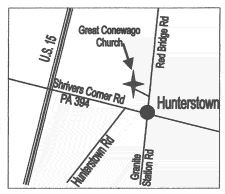
All rights reserved 2008. No use of content without
written permission of Hunterstown1863.
|
 |
 |
 |
|
|
 |
 |
 |
|
|
|
|

